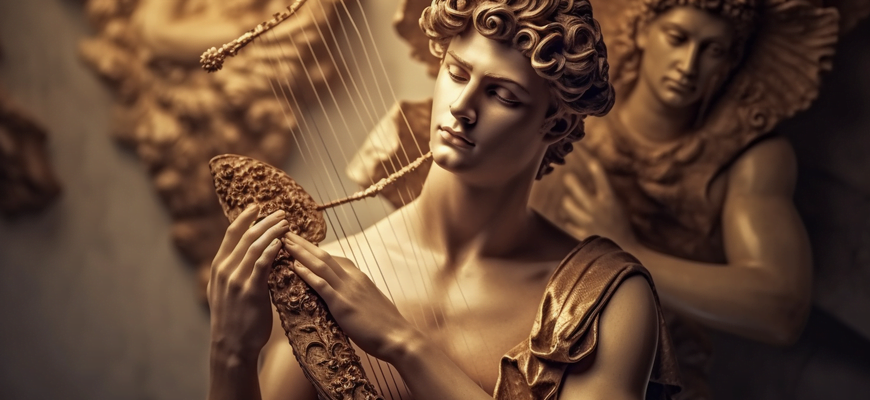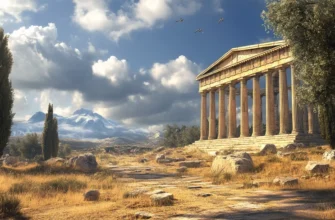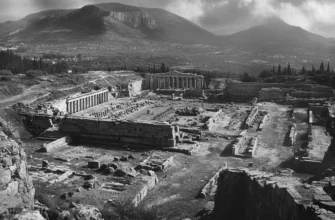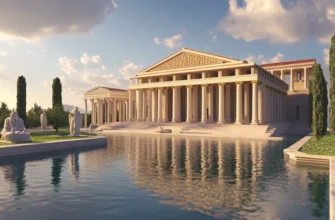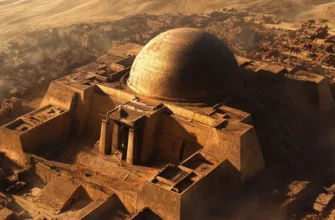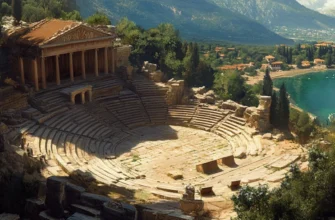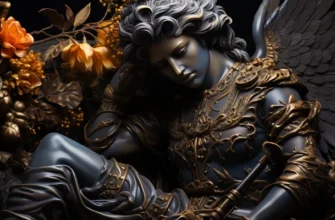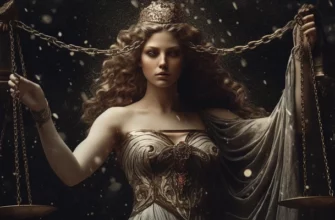Apollo is one of the most famous gods in Greek mythology, who protected art, music, and prophecy. He was the son of the chief god Zeus and the goddess Leto. In mythology, he is credited with many wonderful qualities, for example, he was the god of the sun, literature, healing, and many other areas of human life. The cult of Apollo was very widespread in ancient Greece, and his shrines and temples were located in many cities. In art and literature, Apollo was depicted as a handsome young man with a lyre in his hands. Today, the cult of Apollo is an important part of world culture and art.
- The mythological image of Apollo
- Origin and ancestry
- Myths and legends associated with Apollo
- Symbolism of the god
- The cult of Apollo in ancient Greece
- Shrines and temples
- Religious rituals and festivals associated with Apollo
- The role of the god in Greek life
- Apollo in art and literature
- Depictions of Apollo in Greek art
- Works in which the god Apollo is mentioned
- The influence of the cult of Apollo on the development of Greek culture and art
- Conclusion
The mythological image of Apollo
Apollo is a powerful god in Greek mythology, the son of Zeus and Leto. He was the protector of art, music, and prophecy, and was also associated with the sun, healing, and the muses. In mythology, he is credited with many miraculous abilities, such as predicting the future, healing the sick, and healing wounds. Apollo was often depicted as a handsome young man with a lyre in his hands. He was worshipped in many cities of ancient Greece, where temples and shrines were built in his honor. He also played an important role in Greek culture and art, and his image can be found in many literary works and works of art.
Origin and ancestry
Apollo is the son of Zeus and Leto, who were the supreme deities in Greek mythology. Zeus was the highest god, ruling over thunder and lightning, and also protecting order in the universe. His mother, the goddess Leto, was the patroness of motherhood and female beauty. Legends say that the pregnant Leto wandered the world looking for a place to give birth to her children, but no one would take her in because of Zeus’ wrath. She eventually stopped on the island of Delos, where Apollo was born along with his twin sister Artemis. Apollo was therefore descended from the gods and was known as one of the most influential gods of ancient Greece.
Myths and legends associated with Apollo
In Greek mythology, Apollo appears in many legends and myths. One of the most famous is related to how he defeated Pythia, a monster snake that terrorized the city of Delphi. Another legend is related to how Apollo built a mighty temple in the forest for the hero Bacchus in honor of his father Zeus. Apollo was also associated with the cult of Hyacinth, a young handsome man who died because of the jealousy of the wind god Zephyr towards Apollo. There are many other legends and myths associated with Apollo that tell of his divine qualities and interactions with other gods and humans.
Symbolism of the god
In Greek mythology, Apollo is known for his rich symbolism. One of his main symbols is the lyre, a musical instrument he used to play and sing. Other symbols are associated with his protective qualities: a laurel wreath, symbolizing victory over evil, and a bow and arrows, which he used to defend himself against enemies and evildoers. Apollo is also associated with the sun and light, and therefore his symbols are the color gold, the sun disc, and a sword with a broken blade, which he used to reflect the sun’s rays. In addition, Apollo’s symbols include a fir grove, the southern part of Mount Olympus, a stork, a mouse, and a fox.
The cult of Apollo in ancient Greece
The cult of Apollo was very widespread in ancient Greece. His shrines could be found throughout the country. The most famous of these is the Temple of Apollo at Delphi, where the legendary Pythia was located and where the famous ancient Pythian Games were held. There were also famous shrines in Athens, on the island of Delos, in Corinth, and in other areas. The cult of Apollo was associated with art, music, and healing, and his Byzantine priests acted as musicians, prophets, and doctors. Legends and myths about Apollo also played an important role in ancient Greek culture, and his images can be found on coins, works of art, and other artifacts of that time.
Shrines and temples
Shrines and temples dedicated to Apollo were very common in ancient Greece, as the cult of this god was of great importance to the Greeks. The most famous and important shrine of Apollo was the temple at Delphi, where the legendary Pythia was located. This temple was founded in the 7th century BC and had enormous cultural and religious significance. Important religious ceremonies and prophetic consultations were held here.
In addition to the temple at Delphi, Apollo had other important shrines, including the temple at Olympia, where the Pythian Games were held, and the temple at Athens. There were also temples to Apollo on the island of Delos, in the city of Corinth, on the island of Samos, and in other places throughout Greece.
Many of Apollo’s temples were of great cultural and historical significance. For example, the ruins of the Temple of Apollo in Corinth are considered one of the most remarkable monuments of ancient Greek architecture. All these shrines and temples testify to the importance of the cult of Apollo for ancient Greek culture and religion.
Religious rituals and festivals associated with Apollo
Religious rituals and festivals associated with Apollo were important events in ancient Greek life. The most famous of these were the Pythian Games, which were held every four years in Olympia and were dedicated to Apollo. The games included various competitions, such as running, boxing, archery, and other sports.
Apollo was also honored in temples and shrines throughout Greece. Religious rituals and prophetic consultations were held in temples, while sacrifices and prayers were offered in shrines.
Every year on July 7, the festival of Apollo was celebrated on the island of Delos, where, according to legend, the god was born. This day was dedicated to art and music, as well as to honoring Apollo as the deity of the sun and light.
In general, the cult of Apollo was an important element of ancient Greek religion and culture, and the festivals and rituals associated with it were of great importance to the Greek people.
The role of the god in Greek life
Apollo played an extremely important role in Greek life. As the god of art and music, Apollo was the patron of musicians, poets, and artists, who honored him with their creations. He was also the god of prophecy, and his shrines were places where people went for advice and predictions.
Apollo was also associated with the sun and light, and his cult was popular in places where solar deities were worshipped. In addition, Apollo played an important role in healing, and his temples were places where doctors and other medical professionals sought advice and assistance.
Overall, Apollo was one of the most influential gods in ancient Greek mythology, and his cult and symbolism reflected important aspects of the life and culture of the Greek people.
Apollo in art and literature
Apollo, as the god of art and music, was often depicted in ancient Greek art and literature. He appears on vases, sculptures, and frescoes, usually with a lyre, his symbol. He was also depicted as a handsome young man with a bow and arrows, as he was the god of hunting.
In literature, Apollo was often mentioned in Homer’s poems “The Iliad” and “The Odyssey,” as well as in the works of Roman poets Ovid and Virgil. His name appears in many poems and songs dedicated to the muse and poetry.
In modern art and literature, Apollo also continues to be a popular figure. He is mentioned in many works, such as Rainer Maria Rilke’s Sonnets to Orpheus and Nikolaos Kazantzakis’ Apollo and Ancient Greek Art.
Depictions of Apollo in Greek art
Apollo, as the god of art, was often depicted in ancient Greek art. He appears on vases, sculptures, and frescoes, usually with a lyre, his symbol, or with a bow and arrows, as the god of hunting. Apollo was often depicted as a handsome young man with long hair and an athletic body, which helped convey his agility and grace.
One of the most famous images of Apollo is the statue “Apollo Belvedere,” located in a museum in Rome. This statue depicts Apollo with a bow and arrows, ready to shoot. Other famous images of Apollo include frescoes in the Villa of the Muses, where the god is depicted with musical instruments, and vases with images of Apollo as the god of music and hunting. Images of Apollo are often accompanied by images of his twin sister Artemis, who was the goddess of hunting and nature.
Works in which the god Apollo is mentioned
Apollo, as the god of art, music, and prophecy, is one of the key characters in ancient Greek mythology, so he is mentioned in many works of ancient Greek literature. One of the most famous epics in which Apollo is mentioned is Homer’s Iliad. He is mentioned as the god who supports the Trojans in battle.
In the works of ancient playwrights such as Aeschylus, Sophocles, and Euripides, Apollo is also mentioned as an important character. For example, in Aeschylus’ drama “Oresteia,” Apollo is the god who orders Orestes to kill his mother for killing his father. In other works, Apollo is portrayed as a defender of ideals, justice, and beauty.
Apollo is also mentioned in the works of Roman poets such as Ovid and Virgil. In Ovid’s Metamorphoses, Apollo appears as the god of music and prophecy, and Virgil often refers to Apollo as a symbol of light and truth in his works.
The influence of the cult of Apollo on the development of Greek culture and art
The cult of Apollo had a great influence on the development of Greek culture and art. He was revered as the god of music, poetry, prophecy, and healing. He was the protector of artistic creativity, so many artists and sculptors sought inspiration in the cult of Apollo.
One of the most famous shrines associated with Apollo is the temple at Delphi, where the Oracle of Apollo was located. The ancient Greeks gathered here to receive prophecies from the god. Apollo also had a great influence on architecture, as he was often depicted as a kiosk with several columns and a statue on top.
In art, Apollo was often depicted as a beautiful young man with a lyre or with a bow and arrows. His image was a symbol of beauty and ideals revered in Greek culture. Many artists tried to convey his beauty and ideals in their works.
All these factors helped Apollo become one of the most important gods in ancient Greek mythology and influenced the development of Greek culture and art.
Conclusion
Ancient Greek god Apollo has been preserved in history as one of the most important elements of ancient Greek religion and culture. The god was not only the patron of art and music, but also a prophetic god, a doctor, and a protector of youth and heroes. Images of Apollo can be found in many works of Greek mythology and art, and he played an important role in Greek literature. The cult of Apollo had a great influence on the development of Greek culture and art, particularly on the development of architecture and music. Modern research and interpretations of the cult of Apollo help to better understand the role of the god in ancient Greek civilization and his significance for the modern world.
